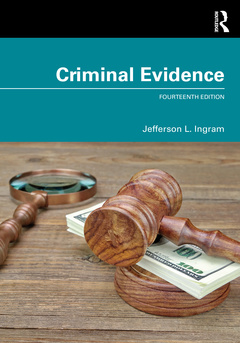Description
Criminal Evidence (14th Ed.)
Author: Ingram Jefferson L.
Language: English
Subjects for Criminal Evidence:
Keywords
Trial Court; Jefferson L; Ingram; Polygraph Evidence; Criminal evidence; Judicial Notice; Evidentiary principles; Sixth Amendment; Criminal law; Unfair Prejudice; Case Law; Affirmative Defense; Justice administration; Fourth Amendment; Constitutional law; Jury Instruction; Criminal procedure; Crack Cocaine; Marital Privilege; Physician Patient Privilege; Attorney Client Privilege; Hearsay Exception; Excited Utterance; Search Incident; Prior Consistent Statements; Witness Spouse; Horizontal Gaze Nystagmus Test; Miranda Warnings; DNA Evidence; Circuit Court; Defendant Spouse; DRE; Polygraph Examination; Adjudicative Fact
Publication date: 05-2021
· 17.8x25.4 cm · Paperback
Publication date: 05-2021
· 17.8x25.4 cm · Hardback
Description
/li>Contents
/li>Biography
/li>
Criminal Evidence is a well-respected and trusted introduction to the rules of criminal evidence for criminal justice students and professionals. Part I of this book generally follows the order and logic of the Federal Rules of Evidence in its explanation of how evidence is collected, preserved, and presented in a criminal court proceeding. Part II provides a selection of edited, relevant criminal court cases that reinforce these basics and provide the context of how these rules are currently practiced. Readers gain an understanding of how concepts of evidence operate to convict the guilty and acquit the innocent.
This 14th Edition provides many updates, new references to recent Supreme Court cases, and a current version of the Federal Rules of Evidence. Student aids include chapter outlines, key terms, concepts lists, a glossary, a table of cases cited, and online case study questions. Teacher resources include an Instructor?s Guide, test bank, and PowerPoint slides.
Updated with all the newest relevant law, this book is appropriate for undergraduate students in criminal evidence and related courses.
Support material for the 14th Edition is available. See menu to the left.
Preface; Acknowledgments; PART I. History and Approach to the Study of Evidence; 1. The Study of Evidence: History, Development, and Approach; Section 1. Proof by Evidence and Substitutes 2. Burden of Proof; 3. Proof via Evidence; 4. Substitutes for Admission of Evidence: Judicial Notice, Stipulations, Inferences, and Presumptions; Section 2.General Admissibility Tests 5. Relevancy and Materiality; 6. Competency of Evidence and Witnesses; Section 3. Evidence via Witness Testimony 7. Examination of Witnesses; 8. Privileges; 9. Opinions and Expert Testimony; 10. Hearsay Rule and Exceptions; 11. Documentary Evidence; 12. Real Evidence; 13. Results of Examinations and Tests; Section 4. Exclusion of Evidence on Constitutional Grounds 14. Evidence Unconstitutionally Obtained; PART II. Judicial Decisions Relating to Part I; Table of Cases in Part II; Cases Relating to Chapter 1; Cases Relating to Chapter 2; Cases Relating to Chapter 3; Cases Relating to Chapter 4; Cases Relating to Chapter 5; Cases Relating to Chapter 6; Cases Relating to Chapter 7; Cases Relating to Chapter 8; Cases Relating to Chapter 9; Cases Relating to Chapter 10; Cases Relating to Chapter 11; Cases Relating to Chapter 12; Cases Relating to Chapter 13; Cases Relating to Chapter 14; Appendix I: Federal Rules of Evidence; Index of Cases; Subject Index
Jefferson L. Ingram holds the rank of Professor in the Department of Political Science at the University of Dayton. He has a B.S. in secondary education, an M.A. in American history, and a Juris Doctor in law. He is a member of the Ohio Bar, the Florida Bar, the Bar of the federal courts for the Southern District of Ohio, and the Bar of the Supreme Court of the United States. He is a co-author (with Jacqueline R. Kanovitz and Christopher J. Devine) of Constitutional Law for Criminal Justice, 15th Edition (2018) and has authored several books on criminal procedure.
These books may interest you

Criminal Evidence 318.89 €



